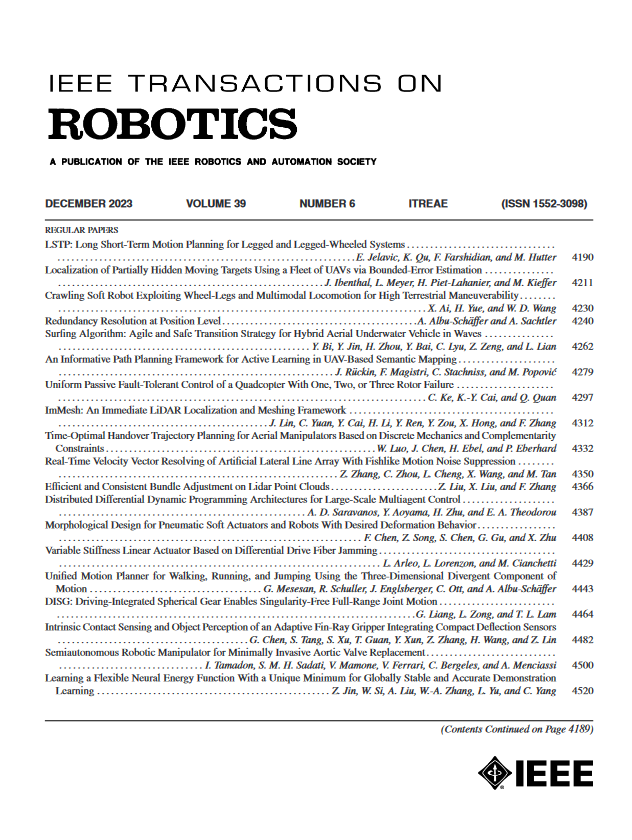具有肌肉样作用力的柔性鱼尾的变形控制和推力分析
IF 9.4
1区 计算机科学
Q1 ROBOTICS
引用次数: 0
摘要
在自然界中,鱼类已经进化出复杂的肌肉系统,使它们能够动态地调节身体运动,以实现高效和敏捷的游泳,这激发了机器鱼紧凑而快速的灵活性调节机制的发展。虽然现有的机器鱼主要依赖于被动柔性机构和可调刚度机构,但这些方法往往缺乏活鱼特有的动态调节能力。本文提出了一种利用大纤维复合材料人造肌肉动态控制其变形的仿生柔性鱼尾。其中鱼尾采用伺服电机作为鞋底驱动关节,人工肌肉调节变形,间接调节刚度。建立了考虑柔韧性和流体力学的动力学模型,并特别建立了一个偏微分方程观测器来估计尾翼的全状态。随后,构建了包含深度强化学习策略的变形控制框架,并通过轻量化设计成功部署在嵌入式平台上。仿真和实验结果验证了动态模型、观测器和控制策略的准确性和有效性。特别是,鱼尾展示了在各种频率范围从15%到203%的鱼类游泳模式中增强推进力的能力。当组装成一个无系绳机器人原型时,变形控制允许原型的游泳速度变化,与被动顺应相比,速度可慢42%或快37%。它的快速可调节性和对不同频率的适应性是以往研究中未广泛报道的重大进展。所得结果将为柔性机器人系统提供一些重要的见解,以提高它们的敏捷性和交互性。本文章由计算机程序翻译,如有差异,请以英文原文为准。
Deformation Control and Thrust Analysis of a Flexible Fishtail With Muscle-Like Actuation
In nature, fish have evolved sophisticated muscular systems that enable them to dynamically regulate their body movements for efficient and agile swimming, which has inspired the development of compact and fast flexibility regulation mechanisms in robotic fish. While existing robotic fish have primarily relied on passive flexible mechanisms and tunable stiffness mechanisms, these approaches often lack the dynamic adjustment capabilities that are characteristic of living fish. This article proposes a novel biomimetic flexible fishtail capable of dynamically controlling its deformation through artificial muscles made from macrofiber composite. In detail, the fishtail is equipped with a servo motor as the sole driving joint, while the artificial muscles regulate the deformation to indirectly adjust stiffness. A dynamic model considering both flexibility and hydrodynamics is established, and a partial differential equation observer is particularly developed to estimate the tail's full states. Subsequently, a deformation control framework incorporating a deep reinforcement learning strategy is constructed and successfully deployed on an embedded platform via lightweight design. Simulation and experimental results validate the accuracy and effectiveness of the dynamic model, observer, and control strategy. Especially, the proposed fishtail demonstrates the ability to enhance propulsion in fishlike swimming modes across various frequencies, ranging from 15% to 203%. When assembled into an untethered robotic prototype, deformation control allows the prototype's swimming speed to vary, achieving up to 42% slower or 37% faster speeds compared to passive compliance. Its rapid adjustability and adaptability to different frequencies represent significant advancements not widely reported in previous studies. The obtained results will offer some significant insights for flexible robotic systems to enhance their agility and interactivity.
求助全文
通过发布文献求助,成功后即可免费获取论文全文。
去求助
来源期刊

IEEE Transactions on Robotics
工程技术-机器人学
CiteScore
14.90
自引率
5.10%
发文量
259
审稿时长
6.0 months
期刊介绍:
The IEEE Transactions on Robotics (T-RO) is dedicated to publishing fundamental papers covering all facets of robotics, drawing on interdisciplinary approaches from computer science, control systems, electrical engineering, mathematics, mechanical engineering, and beyond. From industrial applications to service and personal assistants, surgical operations to space, underwater, and remote exploration, robots and intelligent machines play pivotal roles across various domains, including entertainment, safety, search and rescue, military applications, agriculture, and intelligent vehicles.
Special emphasis is placed on intelligent machines and systems designed for unstructured environments, where a significant portion of the environment remains unknown and beyond direct sensing or control.
 求助内容:
求助内容: 应助结果提醒方式:
应助结果提醒方式:


